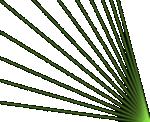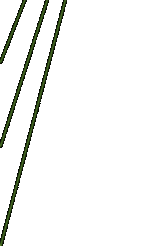|
Features of brightness distribution of Denisyuk's
holograms
The scheme of recording
holograms, developed by Uri. N. Denisyuk [5], is one of most
widespread in a representational holography and provides very high quality of the image in
comparison with other schemes. This scheme is also advanced, because hologram and object
are shined by the same beam of a laser.
However, brightness of
the image reconstructed by Denisyuk’s hologram has characteristic distribution in a
vertical plane: at observation of the hologram from above brightness of image is higher,
than at observation from below. It occurs because in most of holographic schemes for
elimination reflections in a glass of photoplate is used reference beam polarized in a
plane of incidence. It incide on photoplate under the Brewster angle (about 560).
Directions of recording beams and orientation of their electric vectors, as a rule, do not
coincide. It gives decrease of the vector sum of a total light field in specific
directions of distribution and, as result, decrease of brightness of the holographic image
in these directions. For elimination of nonuniformity of a brightness of image in a
vertical plane, for hologram recording, it is possible to use a reference beam with
circular polarization or linear, polarized perpendicularly planes of incidence. In this
case, vector sum of light fields of reference and signal beams is not depend on an angle
between beams and the brightness of image is constant at any angle of observation.
 Simple
calculation, based on the common equation of interference
of two waves [6], gives
that brightness of the restored image BH
will have dependence on an angle between electric
vectors of interfering waves a: Simple
calculation, based on the common equation of interference
of two waves [6], gives
that brightness of the restored image BH
will have dependence on an angle between electric
vectors of interfering waves a:
BH = KCos(a),
where K is coefficient of proportionality.
Figure
shows the scheme of observation of a reflecting
hologram from three various directions: 1- normal
location of an eyes at hologram observation, 2-
observation under 200 higher normal direction,
3- observation under 200 below normal
direction. R- reference source, H- hologram.
Photos of the actual
holographic image which were photographed under the same angles of observation, as well as
in figure: a)- observation from point 2; b)- observation from point 1; c)- observation
from point 3.
In figures the decrease
of brightness and contrast is appreciable at movement of an observation point from top to
down.
The most effective
solution for this problem is using circular polarization of a beam and adding to the
recording scheme an optical wedge for elimination inside reflections.
 Figure
shows position of an optical wedge on a photoplate at recording of the hologram: R-
recording beam, W- wedge, A - wedge angle, H- photoplate, O- object. Figure
shows position of an optical wedge on a photoplate at recording of the hologram: R-
recording beam, W- wedge, A - wedge angle, H- photoplate, O- object.
The wedge angle should
be such, that the spatial frequency of a parasitic interference pattern, created by it,
would be outside the resolution of a human eye. The simple calculations show, that it is
quite enough of a corner of 5-100 to obtain the qualitative image. To avoid an
interference in the photoplate, between it and wedge should be placed an immersion liquid.
As the immersion liquid it is possible to use toluene (n=1,5) or ethylene glycol (n=1,43).
Photos below show the
hologram which was recorded with use of the wedge with angle 50.
These photos show, that
brightness of the images is almost same, independently of a direction of observation.
Small light spots are caused by a poor-quality adhesion of an immersion liquid (toluene)
to the surface of a wedge.
The described method of
recording holograms can present the special interest at recording of a master-hologram,
when the high labour input of manufacturing of a hologram is paid by the subsequent
manufacturing of holograms-copies with the qualitative image.-->
|





